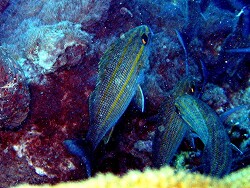Info
The yellow-striped grunt is often found with Acropora stony corals and Acropora palmata.
Brachygenys chrysargyreum is an example of protective mimicry with the yellow sea bream Mulloidichthys martinicus, which is described from the Fernando de Noronha archipelago in northeastern Brazil.
The similarities in color and shape allow the two species to form mixed schools, which increases protection from visually oriented predators for both species.
Brief description:
Adult animals are silver-gray with 5–6 yellow stripes running across the head and body.
All fins except the pectoral fins are yellow, and the inside of the mouth is red.
Juveniles have only three dark stripes, one running from the tip of the snout over the eye to the base of the tail, ending in an upward-curving, elongated black spot at the base of the caudal fin, the second stripe running from the upper edge of the eye along the front half of the lateral line, and the third stripe running from the upper edge of the eye along the back.
Juvenile fish seek protection from predators in seaweed beds.
Synonymised names
Brachygenys chrysargyreus (Günther, 1859) · unaccepted > superseded combination
Brachygenys taeniata (Poey, 1860) · unaccepted
Haemulon chrysargyreum Günther, 1859 · unaccepted > superseded combination
Haemulon serrula (Cuvier, 1830) · unaccepted
Haemulon taeniatum Poey, 1860 · unaccepted (synonym)
Pristipoma serrula Cuvier, 1830 · unaccepted







 Pauline Walsh Jacobson, USA
Pauline Walsh Jacobson, USA








